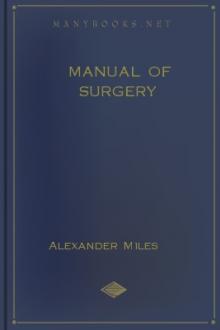Manual of Surgery by Alexis Thomson (golden son ebook .TXT) 📕

- Author: Alexis Thomson
- Performer: -
Book online «Manual of Surgery by Alexis Thomson (golden son ebook .TXT) 📕». Author Alexis Thomson
ion is effected is essentially the same in all tissues, but the extent to which different tissues can carry the recuperative process varies. Simple structures, such as skin, cartilage, bone, periosteum, and tendon, for example, have a high power of regeneration, and in them the reparative process may result in almost perfect restitution to the normal. More complex structures, on the other hand, such as secreting glands, muscle, and the tissues of the central nervous system, are but imperfectly restored, simple cicatricial connective tissue taking the place of what has been lost or destroyed. Any given tissue can be replaced only by tissue of a similar kind, and in a damaged part each element takes its share in the reparative process by producing new material which approximates more or less closely to the normal according to the recuperative capacity of the particular tissue. The normal process of repair may be interfered with by various extraneous agencies, the most important of which are infection by disease
Free e-book «Manual of Surgery by Alexis Thomson (golden son ebook .TXT) 📕» - read online now
Similar e-books:





Comments (0)